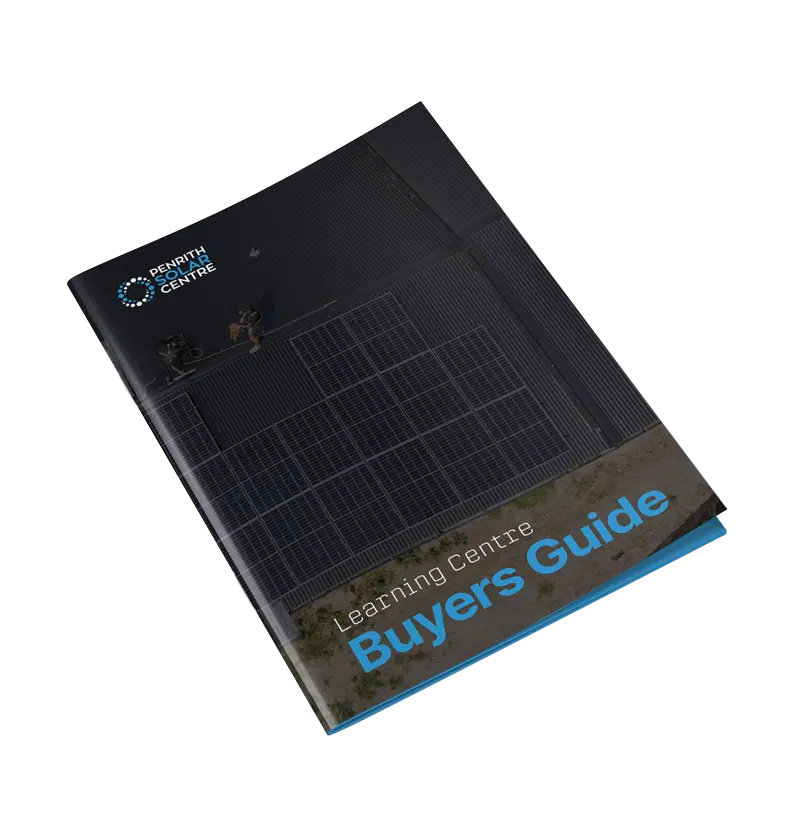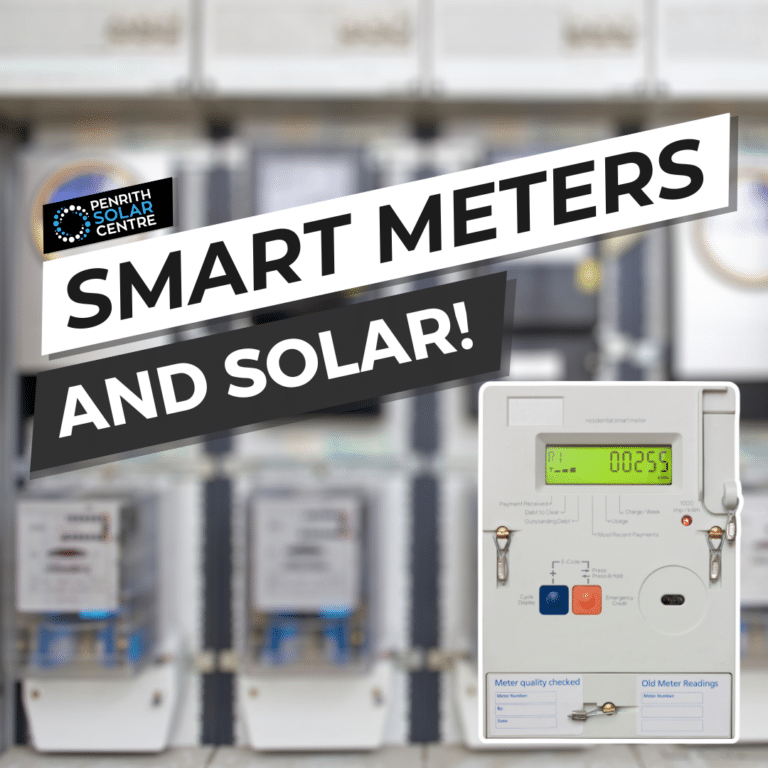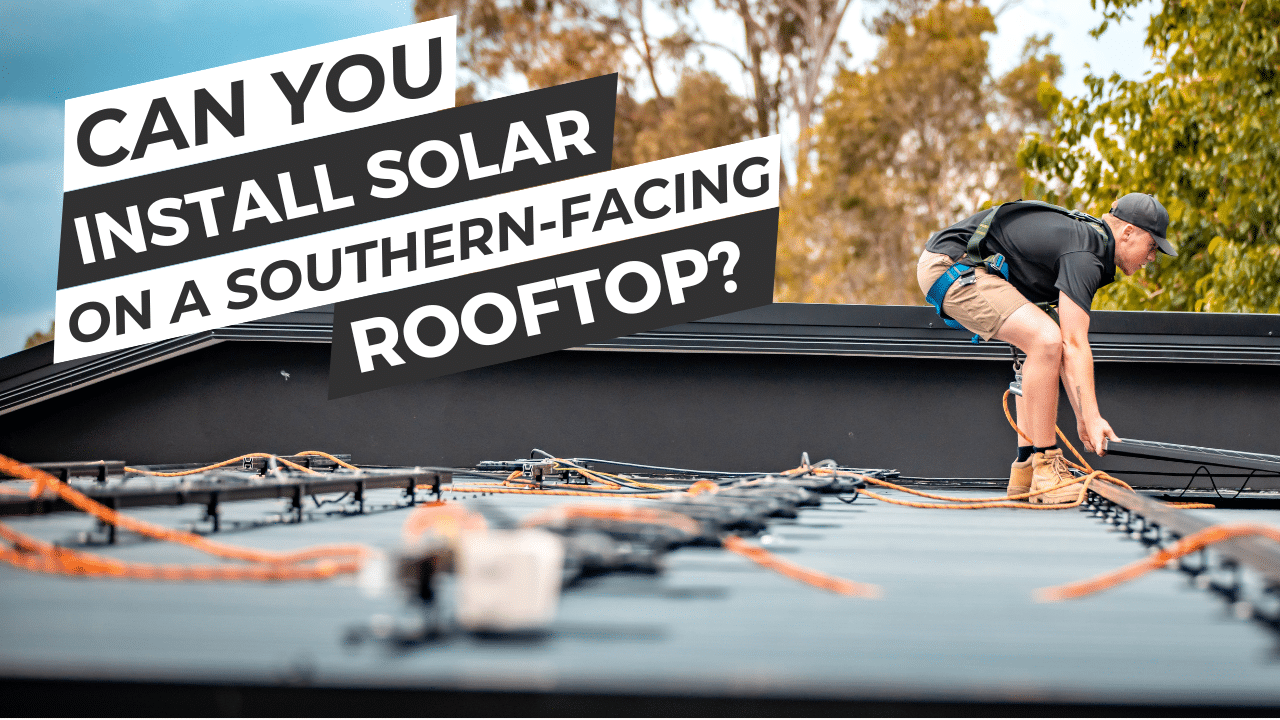
If you’re considering the purchase of a solar system and if you have a southern-facing roof, you’ve probably discovered how divided the solar community can be on the issue of installing panels facing south. Should you install solar panels there? Will it be efficient enough to pay itself off? What will my electrical bills be in the wintertime?
There’s a lot of information out there about the above questions, and honestly, a lot of it is a little outdated. Some of the myths and rumours around installing solar on southern-facing roofs was great information years ago when solar was starting to take off.
These days, solar panels are up to 82% less expensive than they were in 2010. The conversation around efficiency has changed because the technology has evolved and the economics around those advances have followed. This has upended a lot of the “truisms” in the solar industry.
Honestly, a southern-facing roof is not an insurmountable problem. It might require some finesse, but not a problem.
Penrith Solar Centre absolutely loves a challenge. This article is intended to clear up some misconceptions about southern-facing rooftops. In this article, you will discover the following:
- Is Solar Panel Efficiency Sacrificed on Southern-facing Roofs?
- The Impact of Roof Direction on Solar Panels
- The Southern-facing Roof Dilemma
- Energy Consumption Patterns and a Counterintuitive Approach to Installation
- How PSC’s Jake Warner Installed Solar Panels on His Southern-facing Roof
By the end of this article, you’ll be well-informed on the ins and outs of this type of installation. Hopefully, you will also be a bit more interested in exploring that southern-facing real estate on your roof.
Is Solar Panel Efficiency Sacrificed on Southern-facing Roofs?
Absolutely it is. There is no way around this truth in the Australian solar industry. Let’s make sure that’s clear from the get-go.
How much will it affect the efficiency of the solar system?
Well, like so many things in the solar industry, it depends.
We know that isn’t the answer anyone wants to hear. It’s vague and probably feels like we’re trying to obscure an ugly truth from you in order to land a sale. We’re not. It’s just a complex answer.
Let’s get into it.
The first thing you need to understand is the term “pitch.”
Pitch: The pitch (angle of your roof or panels) affects how directly sunlight hits the panels. In general, the optimal pitch for solar panels for most homes in Australia is around 30-35 degrees because of where it is located on planet Earth in relation to the sun.
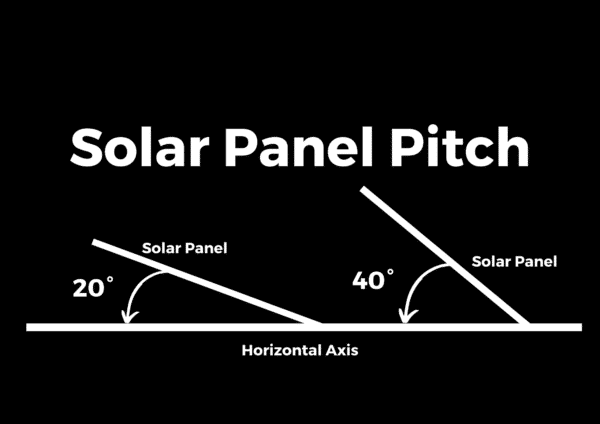
For optimal efficiency, you want to install solar panels at an angle so that the sun’s rays will hit it at a 90° angle.
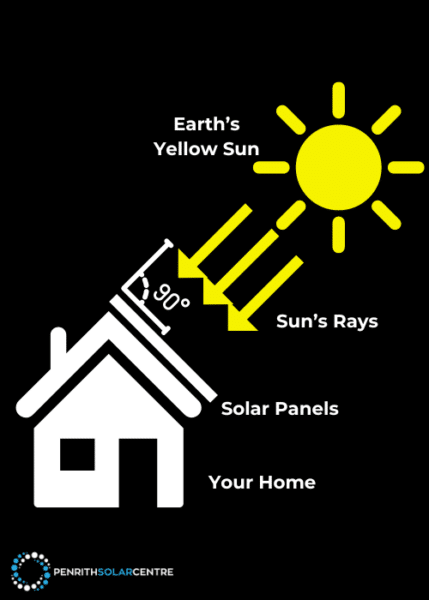
Solar panels mounted at the ideal pitch can maximise energy production throughout the year. Panels with a pitch that deviates significantly from the optimal angle will experience reduced efficiency.
Here’s the thing: how can you get the right pitch for your solar panels that’s going to maximise efficiency year-round?
You can’t. The sun moves in the sky from north to south and back to north again depending on the season. There’s going to be energy inefficiency because of this.
However, solar systems are still outputting electricity all through the winter days. It’s simply performing at a reduced capacity. The important thing you need to ask your solar installer about is how that performance in the winter months will impact your ability to use the electricity it provides. We’re going to speak to that point in the next section.
If you’re interested in learning a bit more about solar panel efficiencies, you might want to check out the following article titled, How Efficient Are Solar Panels? Shade, Heat, and Seasonal Considerations in NSW, Australia.
The Impact of Roof Direction on Solar Panels
The compass direction a roof slope faces does impact the efficiency and electricity production of a solar system. In Australia, because we’re in the Southern Hemisphere, a northern-facing panel performs better than panels facing any other compass direction. It’s about 97% efficient because the sun is in the northern sky most of the year.
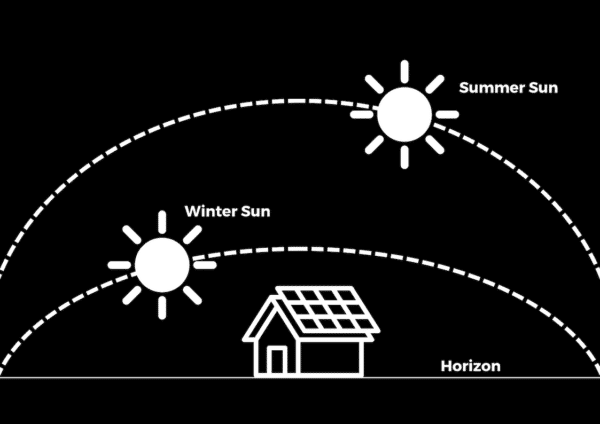
We do a deep dive into this topic in the following article, please check it out if you’re interested in learning more about which direction to point your solar panels. The article is titled, Which Way Should Your Solar Panels Face in Australia?
The eastern-facing panels are harvesting energy from the eastern-rising sun in the morning, and then the western-facing panels take over in the afternoon as the sun slowly makes its way towards a pink and purpling sunset.
Solar panels on the east and west slopes of a roof will get beautiful direct sunlight in the morning and afternoon (respectively), often only performing about 10% less than northern-facing panels. Your east/west panel configuration will be around 90% efficient.
A southern-facing roof will lose about 30% compared to a northern-facing roof depending on location and roof pitch, making those panels around 70% efficient.
Of course, you have to chuck any of the above figures out the window depending on the season. The pitch of the panels and their efficiency will change as the sun shifts in the sky during the year.
The problem (that isn’t really a problem at all, it’s simply misinformation) that some believe needs to be overcome is whether installing solar panels on a southern-facing roof is worth the upfront cost of installing a solar system. In the next section, we’ll give you some information to speak to that concern.
If you’re interested in learning a bit more about how weather affects your solar panels, you might want to check out the following article titled, How Does The Weather Affect Your Solar Panels?
Ready to go solar? click here.
Energy Consumption Patterns and a Counterintuitive Approach to Installation
When are you at home and how much electricity are you using at that time?
The answer to this question is what determines your energy usage patterns.
Any solar installer worth their salt is going to have a detailed conversation with you regarding your energy use patterns before you decide where to place your solar panels. If they don’t, shop around until you find someone who does. Your energy use patterns play a huge role in determining where solar panels should be placed on your roof.
Chances are you’ve already thought about your energy usage patterns, but if you haven’t, here are some important questions to ask yourself regarding your electricity usage:
- What is your typical daily routine? Are you at home during the day when the sun is shining, or is your energy usage concentrated in the morning and evening?
- Consider the appliances you use and the times you operate them. Are you running energy-intensive appliances during the day, or do you primarily use them in the morning and evening?
- Take into account the seasons. Your heating and cooling requirements change with the weather. For instance, during the summer, you might use air conditioning, affecting your electricity usage differently than during the winter. Additionally, your lighting preferences may vary with the season.
- Think about any seasonal activities that may impact your electricity usage. For instance, you may use your pool pump more frequently during the summer but less during the winter.
When evaluating your electricity usage, it’s essential to consider all these factors to make informed decisions about your solar panel placement and system design.
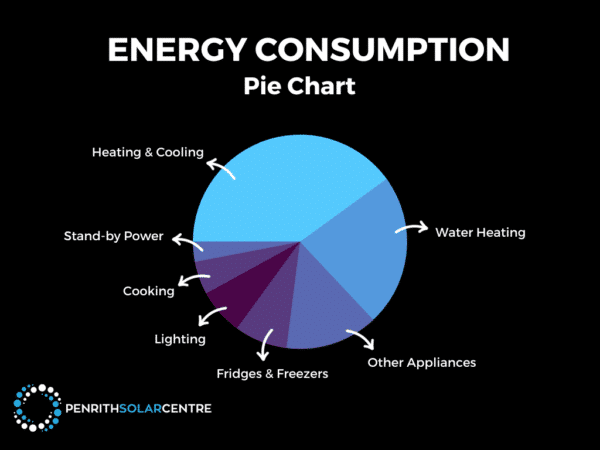
Most households’ energy consumption patterns are similar. Homes in the Sydney metro area use electricity in the morning and in the afternoon/evening hours because residents work or go to school in the middle of the day.
Because you’re using your electricity in the morning and afternoon/evening, you might want to consider installing panels to match that usage pattern: one-third of the panels go on the eastern roof, and two-thirds on the western side. It keeps the home running well from morning to evening based on energy usage patterns. More energy is used in the afternoon, so this design benefits that.
Ignoring the north face might sound counterintuitive, but it works. Other installers might recommend something else, but practical experience matters. Not everyone uses energy in the middle of the day, so having energy in the afternoon is crucial if you don’t have a battery.
Overall, a mix of east and west-facing panels can be a smart choice for solar efficiency, especially if you use energy later in the day.
Once you start to evaluate your energy use patterns and what your energy needs truly are, you’ll start to understand that northern-facing panels aren’t all they’re cracked up to be. East/west panel installation is where it’s at.
Of course, in places like Brisbane, where they are closer to the equator, you’ll often see solar panels facing south. It can make sense there (and about the only thing that makes sense about Queensland – they certainly can’t play rugby).
And in Tasmania, which is far to the south residents might want to find a steeper pitch for their panels and might even be considering mounting their panels on tilts.
If you’re interested in learning a bit more about your energy needs, you might want to check out the following article titled, How Much Solar Do You Need?
The Southern-facing Roof Dilemma
But this article is about southern-facing rooftops, what about those?
In summer, when the sun is high in the sky, southern panels thrive, but the situation changes during winter. While they may perform well in the summer heat, their efficiency drops significantly in the colder months because the sun is closer to the northern horizon.
This can be a concern for those who rely heavily on solar energy during the winter season.
In the wintertime, the sun does shine on southern roofs. It’s at a different angle from the northern-facing rooftops, but those southern roof faces do get sunshine on them.
Most panels on houses are angled at a 20° pitch because they’re installed flush against the pitch of the roof. At that angle, the panels work at 73% efficiency on average year-round, which is pretty good.
But if the panels and roof were steeper, at 30°, they would work at only 63% efficiency year-round average. That’s not as great. So, the angle of the panels mounted on the roof makes a difference. Probably even more than the compass direction they face.

Now if a roof has a 10° pitch, like our founder Jake Warner’s previous home (whose story you’ll read about in a minute), then the compass direction they face is unimportant.
A southern-facing roof with a shallow pitch will perform well year-round.
And in the spirit of that, don’t rule out southern roofs for solar panels. They can be a great option for your home (as long as there’s no shade). It’s all about finding the right angle for the panels, and they’ll do a good job.
Why PSC’s Jake Warner Installed a Lot of Solar Panels on His Southern-facing Roof

In his own words, our founder and director, Jake Warner, discusses the why and how of installing solar panels on his southern-facing roof:
“A few years back, I had a house in the Blue Mountains of New South Wales with 30kW on the roof. It was 85 panels and about 70 of them were facing south. I could only get around 15 panels on the north-facing part of the roof. You know, it’s just the lay of the land and the way that my house was built. Almost the entire roof was slanted South.”
“I laid 85 panels straight on the southern-facing part of the roof and they performed exceptionally well. In summer they performed just as well as the northern-facing panels maybe even better. To be honest, in winter, they performed probably around half the capacity of what we’d expect the north-facing system to perform. It didn’t quite perform as well.”
“Now, not everyone has the luxury to just slap 85 panels on their roof. You know that doesn’t happen unless you’re obsessed with solar. However, you’re always better off installing more panels if you can and you’re better off laying them south if you can’t get them anywhere else on your roof.”
“These days, quite a lot of houses put panels on their southern-facing roof. It’s not uncommon at all, and you should really consider it if you’ve got a pool. We all know that a pool has a bigger load than almost anything else you run. In summer, you have your pumps running 8 hours a day, you have the heater on. In winter, we turn the pool off. Well, we might run for two hours a day as a maintenance sort of thing.”
“It’s important to know that when you’re laying those panels southward, they’re really going to scream in the summertime but lose efficiency in the winter.”
“We don’t all get to pick what way our panels face. The art of solar is using the roof space that’s available, and adjusting it north, east, south, or west.”
“If you install a solar battery, as we did, it actually matters less where you put your panels because the excess energy that you generate will be stored in the battery for when you need it anyway. The whole debate of what compass direction is the best doesn’t necessarily matter as much as it used to. We have a big culture of self-consumption now. Folks are educated about solar now more than ever to generate energy when they’re going to use it. Solar batteries give you the power to shape that energy however you like.”
“In my current home, I’m pretty lucky. I have roof faces on the north, east, and west compass directions. So I’ve got, you know, a pretty even split north, east, and west. I actually have less on my north-facing roof space than I do on the east and the west. The reason for that is that I know I use more energy early morning and late afternoon, particularly late afternoon. My western-facing roof is pretty loaded up. The northern-facing roof has just enough to carry me through the middle of the day. It’s nothing too crazy. It’s probably 20% of my total solar system panels on the northern-facing roof and then the rest maybe 30% on the east and maybe 50% on the west.”
If you’re interested in learning a bit more about the importance of monitoring and programming your energy, you might want to check out the following article titled, What is Consumption Monitoring?
Watt Are You Waiting For?
Choosing the most appropriate roof space to install solar panels on is essential. While considerations like energy consumption patterns should really dictate such decisions, a little more information that demystifies some of those solar panel myths on the internet hopefully helps.
While southern-facing panels might not perform as well as panels on the northern-facing side, it’s not an insurmountable hurdle for your home. Whether or not you choose to install your solar panels on the south side of your roof is entirely up to you with the guidance of a solar installer. It’s something that is definitely worth considering.
At Penrith Solar Centre, we recommend a more straightforward approach to your solar system, as it often produces better results. There are so many potential solutions to the problem of roof real estate.
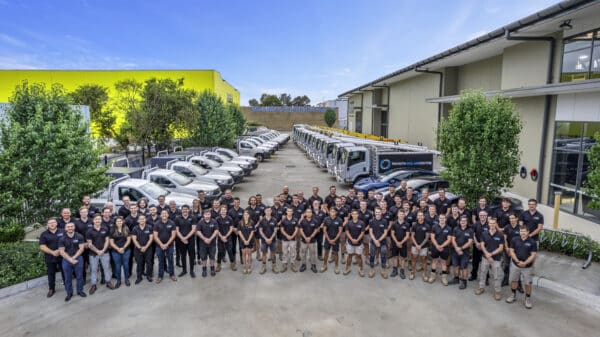
If you’re interested in discovering how you might install solar panels on your roof, you might want to check out the following article on this topic titled How Does Your Roof Affect Your Installation?
